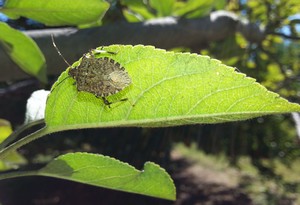PESTS AND DISEASES OF FORESTRY IN NEW ZEALAND
Keeping the Brown Marmorated Stink Bug out of New Zealand
Scion is the leading provider of forest-related knowledge in New Zealand
Formerly known as the Forest Research Institute, Scion has been a leader in research relating to forest health for over 50 years. The Rotorua-based Crown Research Institute continues to provide science that will protect all forests from damage caused by insect pests, pathogens and weeds. The information presented below arises from these research activities.
From Forest Health News 260, September 2015.
Halyomorpha halys, commonly known as the brown marmorated stink bug (BMSB), is a severe crop and fruit pest that originated from Eastern Asia. In the mid-1990s an invasion of BMSB was detected in Pennsylvania USA. The species is highly polyphagous. Within its native range, there are reports of occasional losses of fruit crops including apple, peach, pear and persimmon. In 2010, populations in the USA hit a record high, and commercial fruit orchards incurred substantial losses. Generally, orchard plots most at risk are those bordered by a forest, as the BMSB tends to move regularly between shelter areas (in the forest) and feeding areas in orchards. Due to this behaviour, the worst BMSB damage is found at the edges of orchards bordered by forests or hedge rows. However, during population outbreaks, high levels of damage can occur orchard-wide. Another concern is that BMSB is a vector of a phytoplasma that causes witches’ broom in Paulownia trees, a favourite host tree.

BMSB is believed to have entered the USA as a ‘hitchhiker’ associated with packing crates imported from its native region. BMSB is now established in over 40 states in the USA, and there are reports of establishment in Europe including Switzerland and France. MPI has intercepted BMSB both dead and alive at the New Zealand border in particular from vehicles, sea containers, air freight and passenger luggage. Within the USA, from mid-September there is a four week period of mass dispersal of BMSB to favoured overwintering sites. This results in large aggregations of bugs in dark, dry places, such as attics, warehouses, and wheel arches of vehicles. During this period, there is obviously a higher likelihood of bugs hitchhiking (as above).
With BMSB now firmly established in the USA, researchers are striving to find ways of protecting orchards, with a focus on apple and peach stands. Currently, populations in affected locations are being controlled with the use of monitoring traps and rigorous pesticide regimes. For New Zealand, it is very important that BMSB is not allowed to become established. Projects are underway to study the behaviour and pheromone responses of BMSB in order to develop appropriate detection methods for bugs entering through high risk pathways.
One such project is the detection of BMSB based on its biogenic volatile organic compounds. BMSB and many other stink bugs, when disturbed, produce alarm volatiles with a strong, very characteristic smell (hence the name). Laura Nixon, a Lincoln University/Better Border Biosecurity PhD student, is looking at whether these compounds can be used to chemically detect BMSB associated with imports. Sensitive analytical methods are being dev eloped and tested in order to identify these compounds in large and complex spaces. In this work it is necessary to take into account the context in which BMSB release these alarm compounds. This has led to planned studies, in collaboration with US Department of Agriculture researchers in West Virginia and Maryland, to examine the behaviour of BMSB in response to disturbance whilst they are overwintering and to sample the volatiles emitted by BMSB while they are in this stage. Ultimately, the aim is to develop a reliable chemical detection method for BMSB for circumstances where visual inspections are not suitable or practical.
Laura Nixon (Lincoln University PhD student), Ecki Brockerhoff (Scion), Stephen Goldson (AgResearch) and Michael Rostas (Lincoln University).
This information is intended for general interest only. It is not intended to be a substitute for specific specialist advice on any matter and should not be relied on for that purpose. Scion will not be liable for any direct, indirect, incidental, special, consequential or exemplary damages, loss of profits, or any other intangible losses that result from using the information provided on this site.
(Scion is the trading name of the New Zealand Forest Research Institute Limited.)

 Farm Forestry New Zealand
Farm Forestry New Zealand

